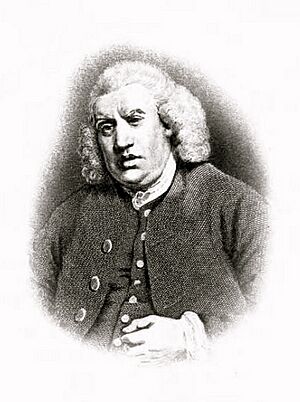George Birkbeck Hill facts for kids
Quick facts for kids
George B. N. Hill
|
|
|---|---|
 |
|
| Born | 7 June 1835 Bruce Castle, Tottenham, Middlesex, England |
| Died | 24 February 1903 (aged 67) Hampstead London, England |
| Occupation | Editor |
| Language | English |
| Nationality | British |
| Alma mater | Pembroke College, Oxford |
| Notable works | Saturday Review; Footsteps of Dr. Johnson in Scotland Letters of Charles George Gordon; |
| Spouse | Annie Scott |
George Birkbeck Hill (born June 7, 1835 – died February 24, 1903) was an English editor and author. He became famous for his detailed work on the writings of Samuel Johnson, a very important writer from the 1700s.
Early Life and Education
George Birkbeck Hill was born at Bruce Castle in Tottenham, England. His father, Arthur Hill, was the headmaster of Bruce Castle School. George was known to his family and friends as Birkbeck. His mother passed away when he was only four years old.
Birkbeck was educated at his father's school. This school followed a special teaching method called the Hazelwood system. This system was unique because it tried to teach without forcing students to learn. It believed in making learning interesting and voluntary.
After Bruce Castle School, Birkbeck went to Pembroke College, Oxford. There, he became good friends with famous artists like Edward Burne-Jones and William Morris. He also started writing articles for a magazine called Oxford and Cambridge Magazine.
In 1856, Birkbeck became very ill with typhoid fever. This illness affected his health for the rest of his life. Because of this, he received an "honorary" degree in 1858. Later, he earned higher degrees for his important contributions to English literature.
Teaching and Writing Career
In 1858, Birkbeck Hill began teaching at Bruce Castle School. He later became the headmaster in 1868, taking over from his father. He led the school until 1877.
On December 29, 1858, he married Annie Scott. She was the sister of one of his old school friends. To make his time as headmaster more interesting, Birkbeck returned to writing and reviewing books. In 1869, he started writing regularly for the Saturday Review, a well-known magazine. He continued writing for them until 1884.
After he stopped teaching, Birkbeck focused on studying English literature from the 1700s. He became known as the most knowledgeable expert on the works of Samuel Johnson. Johnson was a famous writer, poet, and dictionary maker.
Later Life and Legacy
Birkbeck Hill believed in his family's progressive ideas. He strongly supported the Liberal Party in politics. He actively campaigned for William Gladstone, a well-known British Prime Minister, in the mid-1880s.
In 1887, he moved to Oxford. In 1889, he took a trip to Scotland. He followed the same path that Samuel Johnson and his friend James Boswell had taken many years before. However, from 1891 onwards, he often spent his winters abroad for his health.
Birkbeck Hill also edited the published letters of Charles George Gordon. Gordon was a famous British general. This editing job came about because of a family connection. Birkbeck's wife, Annie, was the sister of Sir John Scott. Sir John Scott was a close friend of Charles George Gordon.
Birkbeck's wife, Annie, passed away in October 1902. He died shortly after, in February 1903, in Hampstead, London. Both he and his wife are buried in Aspley Guise. He left his valuable collection of Samuel Johnson's books to Pembroke College, Oxford.
Birkbeck and Annie had seven children, five sons and two daughters. Three of their sons became very successful and were even knighted. These included Sir Maurice Hill, a judge; Sir Norman Hill, an expert in shipping law; and Sir Leonard Erskine Hill, a scientist who studied how the body works. Their older daughter, Margaret, married Sir William James Ashley, a famous economic historian.
Major Works
George Birkbeck Hill's most important works include:
- Dr Johnson, his Friends and his Critics (1878)
- An edited version of Boswell's Correspondence (1879)
- A very important edition of Boswell's Life of Johnson. This included Boswell's Journal of a Tour to the Hebrides and Johnson's Diary of a Journey into North Wales. It was published in six volumes in 1887.
- Footsteps of Dr Johnson in Scotland (1890)
- Johnsonian Miscellanies (two volumes, 1897)
- An edited version of The Memoirs of the Life of Edward Gibbon (1900)
- Johnson's Lives of the Poets (three volumes, 1905)
You can learn more about him from a memoir written by his nephew, Harold Spencer Scott. Also, his younger daughter, Lucy Crump, edited and published his letters in 1903.


